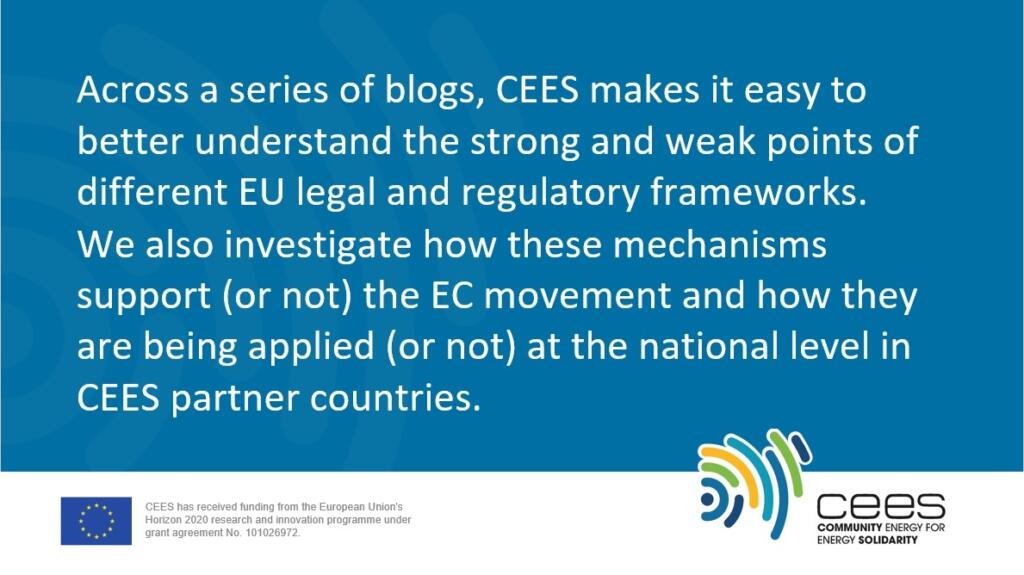Recent EU regulations have strengthened ambition to integrate energy communities (ECs) into the clean energy transition; others oblige Member States to tackle energy poverty. CEES examines how well these initiatives line up.
The principle of subsidiarity is fundamental to how the EU functions. The EU establishes high-level policy frameworks, often with clear targets, but allows Member States flexibility on how they implement national action. Recognising the value of ECs and the need to tackle the growing challenge of energy poverty, the EU created a variety of tools and policy initiatives to support and stimulate national and local actions in both areas. CEES analysis follows the evolution of policy concerning energy poverty and ECs with the aim of seeing how well they align.

Energy poverty first appears within the EU legislative framework in the Second Energy Package (adopted in 2003), namely in the Electricity Directive 2003/54/EC and the Gas Directive 2003/55/EC. Both directives obliged Member States to take appropriate measures to protect end-consumers and, in particular, to ensure “that there are adequate safeguards to protect vulnerable customers, including measures to help them avoid disconnection.”[i] Provisions on more general consumer protection mainly focused on transparency of contractual terms and conditions, general information, dispute settlement mechanisms, and the ability to switch suppliers. Recital 24 of the Electricity Directive provided guidance on how Member States may support vulnerable consumers, for example through payment of electricity bills or “more general measures taken in the social security system.”[ii]
More concrete references to energy poverty were included in the Third Energy Package (adopted in 2009), which also recognised it as a growing problem.[iii] Both the Electricity and Gas Directives established legal requirements for Member States to address energy poverty “where identified,”[iv] including defining the concept of ‘vulnerable customers’ and taking appropriate measures to protect them.[v]
Energy communities were defined as legal entities for the first time in the Clean Energy Package (CEP) (adopted in 2019), based on three features:
- develop and operate local and cooperative production and storage infrastructure for renewable energy
- sell renewable energy to households and businesses, and
- provide energy, energy efficiency, and energy poverty services.
To ensure citizens can be ‘meaningful actors’ in the energy transition, academic literature highlights the need to enable them to participate through not only their investment and consumption decisions, but also as social and political agents who directly shape the energy system.[vi] Driven by collective principles and local need, ECs replace the supplier-consumer relationship with approaches that promote greater interaction and solidarity among members around energy-related issues. As such, ECs can boost energy solidarity and empower citizens to create opportunities for reducing energy costs at the household and community level. ECs can, for example, organise collective supplier switching campaigns, provide energy efficiency services and boost energy know-how that can lead to energy savings.
When considering those living in energy poverty, ECs represent a means of empowering the most vulnerable to ensure that they play a key role in delivering a fair and equitable energy transition.
Both energy poverty and ECs are relevant to the European Commission’s commitment to consumer empowerment as set out in its 2015 publication Communication on the Energy Union Strategy, which states: “Most importantly, our vision is of an Energy Union with citizens at its core, where citizens take ownership of the energy transition, benefit from new technologies to reduce their bills, participate actively in the market, and where vulnerable consumers are protected.”[vii]
In the context of the CEP, revisions to the Renewable Energy Directive, Electricity Market Design Directive, and the Energy Efficiency Directive all represent opportunities to concretely boost consumer engagement in the energy system. Indeed, engaging citizens in ECs could be transformational for tackling energy poverty. The next blog post of this series will explore these three directives in more detail.

[i] Directive 2003/54/EC, Article 3, paragraph 5.
[ii] Directive 2003/54/EC, Recital 24.
[iii] Directive 2009/72/EC, Recital 53; Directive 2009/73/EC, Recital 50.
[iv] Directive 2009/72/EC, Article 8; Directive 2009/73/EC, Article 4.
[v] Directive 2009/72/EC, Article 7; Directive 2009/73/EC, Article 3.
[vi] DellaValle, N. and Czako, V. (2022), Empowering energy citizenship among the energy poor, Energy Research & Social Science
[vii] COM(2015) 80 final, page 2.